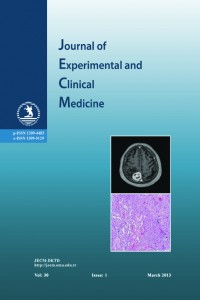Abstract
References
- Board, T.N., Srinivasan, M.S., 2008. The effect of irrigation fluid temperature on core body temperature in arthroscopic shoulder surgery. Arch. Orthop. Traum. Surg. 128, 531-533.
- Daruwalla, Z.J., Halpenny, M., Mullet, H., 2009. Day case shoulder surgery: Satisfactory pain control without regional anaesthesia. A prospective analysis of a perioperative control. Irish J. Med. Sci. 178, 209-213.
- Kim, Y.S., Lee, J.Y., Yang, S.C., 2009. Comparative study of the influence of room-temperature and warmed fluid irrigation on body temparature in arthroscopic shoulder surgery. Arthroscopy. 25, 24-29.
- Marecek, G.S., Saltzman, M.D., 2010. Complications in shoulder arthroscopy. Orthopedics. 33, 492-497. Perlino, C.A., 2001. Postoperative fever. Med. Clin. N. Am. 85, 1141-1149.
- Pile, J.C., 2006. Evaluating postoperative fever: A focused approach. Clev. Clin. J. Med. 73, 62-66.
- Rains, D.D., Rooke, G.A., Wahl, C.J., 2011. Pathomechanisms and complications related to patient positioning and anesthesia during shoulder arthroscopy. Arthroscopy. 27, 532-541.
- Ryan, M., Levy, M.M., 2003. Clinical review: Fever in intensive care unit patients. Crit. Care. 7, 221-225. Venkat, G., Moon, Y.L., 2009. Upper airway compromise by extravasated fluid: A rare complication after arthroscopic repair of atrophic cuff tear. Orthopedics. 32, 48-50.
- Willke, A., Tireli, M., 2009. Postoperatif ateş. ANKEM Derg. 23, 86-88.
- Wortel, C.H., Van Deventer, S.J., Aarden, L.A., 1993. Interleukin-6 mediates host defense responses induced by abdominal surgery. Surgery. 114, 564-570.
Abstract
We have evaluated 57 patients retrospectively who underwent arthroscopic and mini open surgery in our clinic between 24.12.2009-31.12.2011. Twenty of 34 patients with impingement syndrome were treated by arthroscopic surgery and 14 of 34 patients were treated by arthroscopic and mini open surgery. Seven of 23 patients with rotator cuff lesions were treated by arthroscopic surgery and 16 of 23 patients were treated by arthroscopic and mini-open surgery. Temperature over 37 oC was considered as sub febrile temperature. The difference between the highest temperature observed in the postoperative period and the temperature in the preoperative period was calculated and termed as delta temperature. The delta temperature in the arthroscopically treated group was found 1.2± 0.7oC and was 0.8±0.50C in the other group (p<0.05). Time, gender and diagnosis were not a risk factor in the increase in the sub febrile temperature postoperatively. But the method of surgical treatment was found as a risk factor in the increase in sub febrile body temperature (p<0.021). We have seen increase in the subfebril temperature in both arthroscopically alone and arthroscopic+mini-open treated patients but the rise in the subfebrile temperature was higher in the arthroscopically treated patients compared with the other group. The surgical method whether arthroscopy or arthroscopic+mini-open is a risk factor for an increase in post operative temperature.
Keywords
Impingement syndrome Mini-open rotator cuff surgery Postoperative complication Shoulder arthroscopy Subfebrile fever
References
- Board, T.N., Srinivasan, M.S., 2008. The effect of irrigation fluid temperature on core body temperature in arthroscopic shoulder surgery. Arch. Orthop. Traum. Surg. 128, 531-533.
- Daruwalla, Z.J., Halpenny, M., Mullet, H., 2009. Day case shoulder surgery: Satisfactory pain control without regional anaesthesia. A prospective analysis of a perioperative control. Irish J. Med. Sci. 178, 209-213.
- Kim, Y.S., Lee, J.Y., Yang, S.C., 2009. Comparative study of the influence of room-temperature and warmed fluid irrigation on body temparature in arthroscopic shoulder surgery. Arthroscopy. 25, 24-29.
- Marecek, G.S., Saltzman, M.D., 2010. Complications in shoulder arthroscopy. Orthopedics. 33, 492-497. Perlino, C.A., 2001. Postoperative fever. Med. Clin. N. Am. 85, 1141-1149.
- Pile, J.C., 2006. Evaluating postoperative fever: A focused approach. Clev. Clin. J. Med. 73, 62-66.
- Rains, D.D., Rooke, G.A., Wahl, C.J., 2011. Pathomechanisms and complications related to patient positioning and anesthesia during shoulder arthroscopy. Arthroscopy. 27, 532-541.
- Ryan, M., Levy, M.M., 2003. Clinical review: Fever in intensive care unit patients. Crit. Care. 7, 221-225. Venkat, G., Moon, Y.L., 2009. Upper airway compromise by extravasated fluid: A rare complication after arthroscopic repair of atrophic cuff tear. Orthopedics. 32, 48-50.
- Willke, A., Tireli, M., 2009. Postoperatif ateş. ANKEM Derg. 23, 86-88.
- Wortel, C.H., Van Deventer, S.J., Aarden, L.A., 1993. Interleukin-6 mediates host defense responses induced by abdominal surgery. Surgery. 114, 564-570.
Details
| Primary Language | English |
|---|---|
| Subjects | Health Care Administration |
| Journal Section | Surgery Medical Sciences |
| Authors | |
| Publication Date | March 26, 2013 |
| Submission Date | November 12, 2012 |
| Published in Issue | Year 2013 Volume: 30 Issue: 1 |
Cite

This work is licensed under a Creative Commons Attribution-NonCommercial 4.0 International License.

